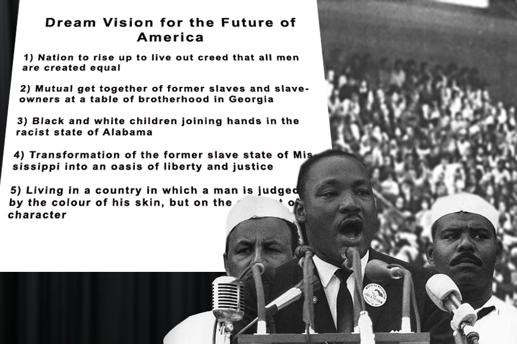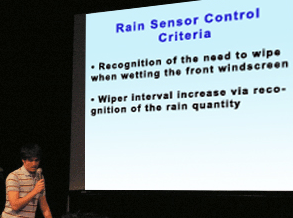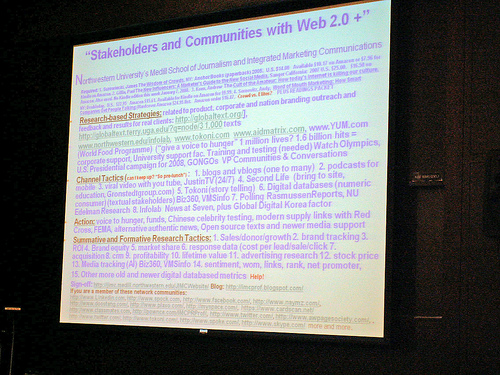The PowerPoint* Dilemma
One finds the following maxim in most books on public speaking: “Address an additional sensory channel during your presentation. This way you increase the retention quotient and the effectiveness of the words.” So: If in addition to language heard (sensory channel ‘ear’), the audience also sees text or an image (sensory channel ‘eye’), the presentation is automatically better. When the first overhead projector entered the market in 1968 a wonderful aid had been discovered to put this maxim into practice. In 1987 Bill Gates acquired the rights to PowerPoint – the program that had slowly displaced the overhead projector and that, today, dominates 95 % of the presentation software market. Regardless of the environment: presentations are nearly always given using Microsoft’s flagship product.
With the aid of a projector the latest turnover figures appear on the screen; the Marketing Department’s latest strategy; the implementation of the newest restructuring measures; the schematic representation of a technical process…
The century speech in the USA
On the 28th of August, 1963 a man ascended a rostrum in front of the Lincoln Memorial in Washington and raised up his voice to a crowd of over 250,000 people. It was to become one of the greatest speeches of the century. The name of the man was Martin Luther King, that charismatic leader of African Americans, whose peaceful struggle made racial segregation in the US later vanish. Later this, his most famous speech, became known by the title “I have a dream”. In fiery language Martin Luther King spelt out his future America. Again and again, he began his sentences with: “I have a dream.” Whoever has seen this speech on television can still sense the awe-inspiring effect of his words in those distant days. Let us imagine the following scenario: PowerPoint* existed in those days, and to drive home his message Martin Luther King had used it to support his core statements on a gigantic screen. That might have then looked something like this:

Of course, making use of the full gamut of playful options of this program, these statements would have floated into the picture from left to right, as if guided by some spectral hand… 250,000 people would have already read what Mr. King would have then repeated almost verbatim… His otherwise so vivid language would have had to have been adapted to the academic text on the slide… And you can be certain, that one of the greatest speeches of humankind would have been lessened by a factor of ten! I suspect that with a PowerPoint* supported speech on racial segregation in the US it still would not have been abolished.
At the turn of the current century, one principle of effective speech has become clear: it is not so much about the CONTENT of the speech. That is only wishful- thinking on the part of most speakers. Studies show, that audiences only just manage to retain a slender seven percent! Transposing this to the speech it would mean that, taking a generous calculation, of the 250,000 people present, less than 1 % could subsequently have been able to summarize all of his seven dream visions. It is not the content conveyed that is decisive in terms of effectiveness – that is a fallacy that has stubbornly lodged itself in the minds of most public speaking trainers. Of far greater importance is the emotion, that this content engenders in people. That is all it is about. And Martin Luther King did engender emotions, whereby it is of no consequence how many details of the speech the audience managed to retain.
PowerPoint* blocks the flow of energy and impedes emotions
By using PowerPoint* you will not achieve an increase in the retention quotient. This is a myth. But what certainly happenes is a decrease in triggered emotions.
The fact is: You DEVALUATE a message if it is simultaneously shown on a slide! Text on slides inhibits emotions. Text on slides kill suspense. Text on slides impedes effect. Everything else is fine sounding, but hollow theory. And PowerPoint is the most dominant protagonist in these effectiveness-inhibiting battles. Many people think that it is different with images, schematic representations, and diagrams. Unfortunately not! Because - as can be proved - text always kills suspense, even when it is used to label diagrams, charts or images.
The most fervent PowerPoint* advocates are usually the presenters, but not the audience. Everyone complains about PowerPoint but nobody does anything against it, and, in the absence of an alternative, people cling bravely to the tradition. In almost every case, when I am told about a speaker, who was able to enthuse the audience, I will ask whether he worked with PowerPoint*. It turns out that in 95 of 100 cases they spoke freely -without PowerPoint*. People convince - technical aids do not.
Of course there are exceptions – speakers who can give a good presentation despite PowerPoint*. But this is the same as fastening your seatbelt in a car. Just because it happened 5 out of 1000 times that the non-fastening of the seatbelt saved a life during an accident, one cannot justify that the non-fastening is the principle to stick to. Just because it happened that someone gave a good speech with PowerPoint* one can’t justify that using PowerPoint* is the principle to stick to.
As long as one has not yet become acquainted with the alternative method that I suggest on this website, one will be tempted to believe that PowerPoint* is the nonplus ultra if only one uses it correctly. But we can prove No!
When you use PowerPoint* the audience’s eyes are directed rigidly at the screen. The human being is subject to a reading compulsion. You can omit the speaker altogether. This is assisted reading!
When you observe carefully you will recognize that the energy of the audience is decreasing as soon as a projector projects something onto the wall. You can actually feel that. What is even more dramatic: The exchange of energy between the speaker and the audience is blocked by PowerPoint*. You divide the attention instead of focusing it. Convincing is being impeded.
The Noun Issue of PowerPoint*
The serious problem with PowerPoint* is that speech is forced into a structure, which works against the natural flow of speech. Speech is cut up into small bites.
PowerPoint* leads to substantiation and the formulation of word-monstrosities, which can only be processed by the mind, where your emotions are not triggered. That, which is normally expressed with a verb, becomes a noun in a PowerPoint*. An example: The two freely spoken sentences: “The rain sensor recognizes if it’s raining and turns on the windscreen wipers. The rain sensor senses, how hard it is raining and switches the wipers to faster”, get hacked into noun-slogan sentences with PowerPoint*:

Unfortunately the following then happens during the presentation. The speaker, who is using the charts as cue-card notes reads the sentence with a glance before he starts to speak. The expression on the slide enters his short-term memory, so that it becomes almost impossible for him to express it in vivid every-day language. So he more or less reads this disastrous sentence verbatim. After about five or six slides at the latest, no one in the room is listening. Participants in my seminars brought me PowerPoint* presentations, with 126 (!) slides of this kind shown in a row.
To date Microsoft’s PowerPoint* has been sold several 100 million times worldwide. It is estimated that around 30 million (!) PowerPoint* presentations are shown per day. You can take it as read that humanity is being rocked to sleep with several hundred billion slides like this every month.
The following scenario is happening in Switzerland, Austria, and Germany ten thousand times on a daily bases. On a planetary scale it is happening a million time: A speaker presents for two hours in front of 50 executives. PowerPoint is on! The information flashes through the short-term memory never to appear again; after ten minutes thoughts start drifting off to knocking off time – motivation is not created, but, rather, it is destroyed. 50 executives cost a company about 7,000 Euros in two hours – not including the work, which is left undone during this time. If one assumes that for every 100 employees five presentations of this type are held per week, and multiply that with the around 41 million employees in Germany, then about 1.6 billion Euros are blown like this every month throughout Germany… Every month. Month after month, year after year.
Viewed liked this it would make economic sense to outlaw PowerPoint* and ready-made slides. It would help save individual companies millions and would generate billions for the national economy.
Read about the detailed calculation of the economic damage due to PPT.
In the book “The PowerPoint Fallacy – Still presenting or already fascinating?” you learn, why you can renounce PowerPoint forever - and, above all, with what alternative you can create a five times higher effect. The PowerPoint Fallacy - order here.

*PowerPoint is named as a representaive of all presentation software

